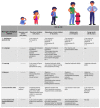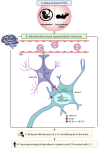Neuropsychological Alterations in Patients with Congenital Hypothyroidism Treated with Levothyroxine: Linked Factors and Thyroid Hormone Hyposensitivity
- PMID: 35743497
- PMCID: PMC9224966
- DOI: 10.3390/jcm11123427
Neuropsychological Alterations in Patients with Congenital Hypothyroidism Treated with Levothyroxine: Linked Factors and Thyroid Hormone Hyposensitivity
Abstract
Eighty-five percent of the studies of patients with congenital hypothyroidism (CH) treated with Levothyroxine (L-T4) report neuropsychological sequelae throughout life. In neonates and infants, there is a deficit in sensorimotor skills (impaired balance). In preschool and elementary school children and adolescents, there are alterations in intellectual quotient (low scores), language (delayed phonological acquisition), memory (visual, verbal, visuospatial, visuoconstructive, autobiographical, and semantic), sensorimotor skills (impaired fine and gross motor control), and visuoconstructive-visuospatial domain (low scores in spatial location, block design, and object assembly). These neuropsychological domains are also affected in young adults, except for language (adequate verbal fluency) and visuoconstructive-visuospatial domain (no data). The onset and severity of neuropsychological sequelae in patients with treated CH depend on several factors: extrinsic, related to L-T4 treatment and social aspects, and intrinsic, such as severity and etiology of CH, as well as structural and physiological changes in the brain. In this review, we hypothesized that thyroid hormone hyposensitivity (THH) could also contribute to neuropsychological alterations by reducing the effectiveness of L-T4 treatment in the brain. Thus, further research could approach the THH hypothesis at basic and clinical levels to implement new endocrinological and neuropsychological therapies for CH patients.
Keywords: IQ; adolescents; infants; language; learning; memory; preschoolers; school children; sensorimotor; visuoconstructive; visuospatial; young adults.
Conflict of interest statement
The authors declare no conflict of interest.
Figures




Similar articles
-
Neuropsychological follow-up in early-treated congenital hypothyroidism: a problem-oriented approach.Thyroid. 2000 Mar;10(3):243-9. doi: 10.1089/thy.2000.10.243. Thyroid. 2000. PMID: 10779139
-
School attainments in children with congenital hypothyroidism detected by neonatal screening and treated early in life.Eur J Endocrinol. 1999 May;140(5):407-13. doi: 10.1530/eje.0.1400407. Eur J Endocrinol. 1999. PMID: 10229905 Clinical Trial.
-
Congenital hypothyroidism: influence of disease severity and L-thyroxine treatment on intellectual, motor, and school-associated outcomes in young adults.Pediatrics. 2003 Oct;112(4):923-30. doi: 10.1542/peds.112.4.923. Pediatrics. 2003. PMID: 14523187
-
Congenital hypothyroidism clinical aspects and late consequences.Pediatr Endocrinol Rev. 2003 Dec;1 Suppl 2:185-90; discussion 190. Pediatr Endocrinol Rev. 2003. PMID: 16444157 Review.
-
Congenital hypothyroidism.Orphanet J Rare Dis. 2010 Jun 10;5:17. doi: 10.1186/1750-1172-5-17. Orphanet J Rare Dis. 2010. PMID: 20537182 Free PMC article. Review.
Cited by
-
Congenital hypothyroidism and associated visual-motor and intellectual development.Pediatr Res. 2025 Jan 22. doi: 10.1038/s41390-025-03850-3. Online ahead of print. Pediatr Res. 2025. PMID: 39843775
-
Higher initial levothyroxine doses and very early treatment start may lead to better cognitive outcomes in children with congenital hypothyroidism.Acta Paediatr. 2025 Mar;114(3):594-602. doi: 10.1111/apa.17479. Epub 2024 Nov 1. Acta Paediatr. 2025. PMID: 39487608 Free PMC article.
-
50 YEARS OF NEWBORN SCREENING FOR CONGENITAL HYPOTHYROIDISM: EVOLUTION OF INSIGHTS IN ETIOLOGY, DIAGNOSIS AND MANAGEMENT: Management during pregnancy and long-term outcomes of adult patients with congenital hypothyroidism.Eur Thyroid J. 2025 Jul 11;14(4):e250125. doi: 10.1530/ETJ-25-0125. Print 2025 Aug 1. Eur Thyroid J. 2025. PMID: 40570035 Free PMC article. Review.
References
-
- Van Trotsenburg P., Stoupa A., Léger J., Rohrer T., Peters C., Fugazzola L., Cassio A., Heinrichs C., Beauloye V., Pohlenz J., et al. Congenital Hypothyroidism: A 2020–2021 Consensus Guidelines Update—An ENDO-European Reference Network Initiative Endorsed by the European Society for Pediatric Endocrinology and the European Society for Endocrinology. Thyroid. 2021;31:387–419. doi: 10.1089/thy.2020.0333. - DOI - PMC - PubMed
-
- Rivera-Hernández A., Huerta-Martínez H., Centeno-Navarrete Y., Flores-Escamilla R., Zurita-Cruz J.N. Actualización En Hipotiroidismo Congénito: Definición, Epidemiología, Embriología y Fisiología. Primera Parte. Rev. Mex. Pediatría. 2017;84:204–209.
Publication types
Grants and funding
LinkOut - more resources
Full Text Sources

